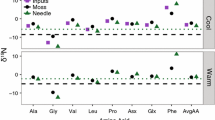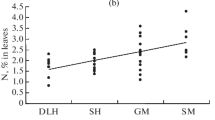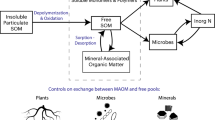Abstract
Uptake of nitrogen (N) via root-mycorrhizal associations accounts for a significant portion of total N supply to many vascular plants. Using stable isotope ratios (δ15N) and the mass balance among N pools of plants, fungal tissues, and soils, a number of efforts have been made in recent years to quantify the flux of N from mycorrhizal fungi to host plants. Current estimates of this flux for arctic tundra ecosystems rely on the untested assumption that the δ15N of labile organic N taken up by the fungi is approximately the same as the δ15N of bulk soil. We report here hydrolysable amino acids are more depleted in 15N relative to hydrolysable ammonium and amino sugars in arctic tundra soils near Toolik Lake, Alaska, USA. We demonstrate, using a case study, that recognizing the depletion in 15N for hydrolysable amino acids (δ15N = −5.6‰ on average) would alter recent estimates of N flux between mycorrhizal fungi and host plants in an arctic tundra ecosystem.

Similar content being viewed by others
Abbreviations
- C:
-
Carbon
- HAA:
-
Hydrolysable amino acids
- HAS:
-
Hydrolysable amino sugars
- HNH4 + :
-
Hydrolizable ammonium
- N:
-
Nitrogen
- NH4 + :
-
Ammonium
- NO3 − :
-
Nitrate
- TDN:
-
Total dissolved N
References
Abuzinadah RA, Read DJ (1986a) The role of proteins in the nitrogen nutrition of ectomycorrhizal plants—I. Utilization of peptides and proteins by ectomycorrhizal fungi. New Phytol 103:481–493
Abuzinadah RA, Read DJ (1986b) The role of proteins in the nitrogen nutrition of ectomycorrhizal plants—III. Protein utilization by Betula, Picea and Pinus in mycorrhizal association with Hebeloma crustuliniforme. New Phytol 103:507–514
Bol R, Ostle NJ, Petzke KJ, Chenu CC, Balesdent J (2008) Amino acid 15N in long-term bare fallow soils: influence of annual N fertilizer and manure applications. Euro J Soil Sci 59:617–629
Cabrera ML, Beare MH (1993) Alkaline persulfate oxidation for determining total nitrogen in microbial biomass extracts. Soil Sci Soc Am J 57:1007–1012
Chalot M, Blaudez D, Brun A (2006) Ammonia: a candidate for nitrogen transfer at the mycorrhizal interface. Trends Plant Sci 11:263–266
Chapin FS III, Fetcher N, Kielland K et al (1988) Productivity and nutrient cycling of Alaskan tundra: enhancement by flowing soil water. Ecology 69:693–702
Chapin FS III, Shaver GR, Giblin AE et al (1995) Response of arctic tundra to experimental and observed changes in climate. Ecology 76:694–711
Clemmensen KE, Michelsen A (2006) Integrated long-term responses of an arctic-alpine willow and associated ectomycorrhizal fungi to an altered environment. Can J Bot 84:831–843
Clemmensen KE, Michelsen A, Jonasson S et al (2006) Increased ectomycorrhizal fungal abundance after long-term fertilization and warming of two arctic tundra ecosystems. New Phytol 171:391–404
Clemmensen KE, Sorensen PL, Michelsen A et al (2008) Site-dependent N uptake from N-form mixtures by arctic plants, soil microbes and ectomycorrhizal fungi. Oecologia 155:771–783
Dijkstra P, Ishizu A, Doucett R et al (2006) 13C and 15N natural abundance of the soil microbial biomass. Soil Biol Biochem 38:3257–3266
Emmerton KS, Callaghan TV, Jones HE et al (2001a) Assimilation and isotopic fractionation of nitrogen by mycorrhizal and nonmycorrhizal subarctic plants. New Phytol 151:513–524
Emmerton KS, Callaghan TV, Jones HE et al (2001b) Assimilation and isotopic fractionation of nitrogen by mycorrhizal fungi. New Phytol 151:503–511
Fogel ML, Tuross N (1999) Transformation of plant biochemicals to geological macromolecules during early diagenesis. Oecologia 120:336–346
Friedel JK, Scheller E (2002) Composition of hydrolysable amino acids in soil organic matter and soil microbial biomass. Soil Biol Biochem 34:315–325
Giblin AE, Laundre JA, Nadelhoffer KJ et al (1994) Measuring nutrient availability in arctic soils using ion exchange resins: a field test. Soil Sci Soc Am J 58:1154–1162
Hinzman LD, Kane DL, Benson CS (1996) Energy balance and hydrological processes in an arctic watershed. In: Reynolds JF, Tenhunen JD et al (eds) Landscape function and disturbance in arctic tundra, Ecological Studies 120. Springer, Berlin
Hobbie JE, Hobbie EA (2006) 15N in symbiotic fungi and plants estimates nitrogen and carbon flux rates in arctic tundra. Ecology 87:816–822
Hobbie EA, Wallander H (2005) Integrating ectomycorrhizal fungi into quantitative frameworks of forest carbon and nitrogen cycling. In: Gadd G (ed) Fungi in biogeochemical cycles. Cambridge University Press, New York
Hobbie EA, Macko SA, Shugart HH (1999) Insights into nitrogen and carbon dynamics of ectomycorrhizal and saprotrophic fungi from isotopic evidence. Oecologia 118:353–360
Hobbie EA, Macko SA, Williams M (2000) Correlations between foliar δ15N and nitrogen concentrations may indicate plant-mycorrhizal interactions. Oecologia 122:273–283
Holmes RM, McClelland JW, Sigman DM et al (1998) Measuring 15N-NH4 + in marine, estuarine and fresh waters: an adaptation of the ammonia diffusion method for samples with low ammonium concentrations. Mar Chem 60:235–243
Keeney DR, Nelson DW (1982) Nitrogen in organic forms. In: Page AL et al (eds) Methods of soil analysis, Part 2. Agronomy No. 9. Am Soc Ag, Madison
Kerley SJ, Read DJ (1995) The biology of mycorrhiza in the ericaceae. XVIII. Chitin degradation by Hymenoscyphus ericae and transfer of chitin-nitrogen to the host plant. New Phytol 131:369–375
Kerley SJ, Read DJ (1997) The biology of mycorrhiza in the ericaceae. XIX. Fungal mycelium as a nitrogen source for the ericoid mycorrhizal fungus Hymenoscyphus ericae and its host plants. New Phytol 136:691–701
Kielland K, McFarland J, Olson K (2006) Amino acid uptake in deciduous and coniferous taiga ecosystems. Plant Soil 288:297–307
Knicker H (2004) Stabilization of N-compounds in soil and organic-matter-rich sediments—what is the difference? Mar Chem 92:167–195
Kramer MG, Sollins P, Sletten RS et al (2003) N isotope fractionation and measures of organic matter alteration during decomposition. Ecology 84:2021–2025
Lipson DA, Monson RK (1998) Plant–microbe competition for soil amino acids in the alpine tundra: effects of freeze–thaw and dry–rewet events. Oecologia 113:406–414
Macko SA, Estep MLF (1984) Microbial alteration of stable nitrogen and carbon isotopic composition of organic matter. Org Geochem 6:787–790
Macko SA, Fogel Estep KL, Engel MH et al (1986) Kinetic fractionation of stable nitrogen isotopes during amino acid transamination. Geochim Cosmochim Acta 50:2143–2146
McKane RB, Johnson LC, Shaver GR et al (2002) Resource-based niches provide a basis for plant species diversity and dominance in arctic tundra. Nature 415:68–71
Michelsen A, Quarmby C, Sleep S et al (1998) Vascular plant 15N natural abundance in heath and forest tundra ecosystems is closely correlated with presence and type of mycorrhizal fungi in roots. Oecologia 115:406–418
Mulvaney RL, Khan SA (2001) Diffusion methods to determine different forms of nitrogen in soil hydrolysates. Soil Sci Soc Am J 65:1284–1292
Nadelhoffer K, Shaver G, Fry B et al (1996) 15N natural abundances and N use by tundra plants. Oecologia 107:386–394
Ostle NJ, Bol R, Petzke KJ et al (1999) Compound specific δ15Ν% values: amino acids in grassland and arable soils. Soil Biol Biochem 31:1751–1755
Read DJ, Perez-Moreno J (2003) Mycorrhizas and nutrient cycling in ecosystems—a journey towards relevance? New Phytol 157:475–492
Schimel JP, Bennett J (2004) Nitrogen mineralization: challenges of a changing paradigm. Ecology 85:591–602
Schimel JP, Chapin FS III (1996) Tundra plant uptake of amino acid and NH4 + nitrogen in situ: plants compete well for amino acid N. Ecology 77:2142–2147
Selle A, Willmann M, Grunze N, Geßler A, Weiß M, Nehls U (2005) The high-affinity poplar ammonium importer PttAMT1.2 and its role in ectomycorrhizal symbiosis. New Phytol 168:697–706
Shaver GR, Nadelhoffer KJ, Giblin AE (1991) Biogeochemical diversity and element transport in a heterogeneous landscape, the North Slope of Alaska. In: Turner MG, Gardner RH (eds) Quantitative methods in landscape ecology. Springer, New York
Shaver GR, Candell J, Chapin FS III et al (2000) Global warming and terrestrial ecosystmes: a conceptual framework for analysis. BioSci 50:871–882
Shaver GR, Bret-Harte SM, Jones MH et al (2001) Species composition interacts with fertilizer to control long-term change in tundra productivity. Ecology 82:3163–3181
Sigman DM, Altabet MA, Michener R et al (1997) Natural abundance-level measurement of the nitrogen isotopic composition of oceanic nitrate: an adaptation of the ammonia diffusion method. Mar Chem 57:227–242
Smith S, Read D (1997) Mycorrhizal symbiosis, 2nd edn. Academic Press, San Diego
Taylor AFS, Högbom L, Högberg M et al (1997) Natural 15N abundance in fruit bodies of ectomycorrhizal fungi from boreal forests. New Phytol 136:713–720
Taylor AFS, Gebauer G, Read DJ (2004) Uptake of nitrogen and carbon from double-labelled (15N and 13C) glycine by mycorrhizal pine seedlings. New Phytol 164:383–388
Urcelay C, Bret-Harte MS, Daz S et al (2003) Mycorrhizal colonization mediated by species interactions in arctic tundra. Oecologia 137:399–404
Walker DA, Walker MD (1996) Terrain and vegetation of the Imnavait Creek watershed. In: Reynolds JF, Tenhunen JD (eds) Landscape function and disturbance in arctic tundra, Ecological Studies 120. Springer, Berlin
Werner RA, Schmidt HL (2002) The in vivo nitrogen isotope discrimination among organic plant compounds. Phytochem 61:465–484
Zang X, van Heemst JDH, Dria KJ et al (2000) Encapsulation of protein in humic acid from a histosol as an explanation for the occurrence of organic nitrogen in soil and sediment. Org Geochem 31:679–695
Zhang X, Amelung W, Yuan Y et al (1999) Land-use effects on amino sugars in particle size fractions of an Argiudoll. Appl Soil Ecol 11:271–275
Zeller B, Brechet C, Maurice JP et al (2007) 13C and 15N isotopic fractionation in trees, soils and fungi in a natural forest stand and a Norway spruce plantation. Annal For Sci 64:419–429
Acknowledgements
We are grateful to Erik Hobbie and John Hobbie for their insightful comments on the manuscript; Marshall Otter for isotope analyses; Christie Haupert, Jim Laundre, and Carrie McCalley for their field and laboratory assistance. We acknowledge Northland College for the use of facility. This study was funded by NSF-DEB-0423385and NSF-DEB 0444592. Additional support was provided by Arctic Long Term Ecological Research program, funded by National Science Foundation, Division of Environmental Biology.
Author information
Authors and Affiliations
Corresponding author
Rights and permissions
About this article
Cite this article
Yano, Y., Shaver, G.R., Giblin, A.E. et al. Depleted 15N in hydrolysable-N of arctic soils and its implication for mycorrhizal fungi–plant interaction. Biogeochemistry 97, 183–194 (2010). https://doi.org/10.1007/s10533-009-9365-1
Received:
Accepted:
Published:
Issue Date:
DOI: https://doi.org/10.1007/s10533-009-9365-1




